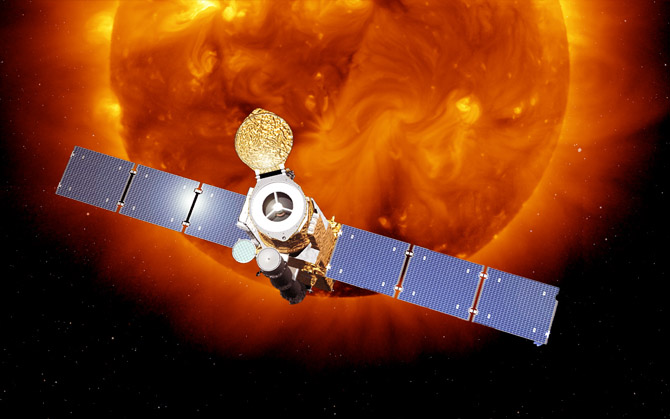Solar Observing Satellite Hinode
MSSL leads the consortium that built and operates the EUV Imaging Spectrometer (EIS) which provides plasma diagnostics in the solar chromosphere, transition region and corona. 2006

23 August 2006
The Solar Observing Satellite Hinode mission will study the generation, transport, and dissipation of magnetic energy from the photosphere to the corona and will record how energy stored in the sun's magnetic field is released, either gradually or violently, as the field rises into the sun’s outer atmosphere.
The Extreme Ultraviolet Imaging Spectrometer
Although capable of generating images, the primary function of Extreme Ultraviolet Imaging Package is to measure the flow velocity, or speed of solar particles, and diagnose the temperature and density of solar plasma -- the ionized gas that surrounds the sun, its corona and beyond. The Extreme Ultraviolet Imaging Package provides a crucial link between the other two instruments because it can measure the layers that separate the photosphere from the corona -- an area known as the chromosphere and the chromosphere-corona transition. The spectrometer was developed by the Mullard Space Science Laboratory of the University College London in the United Kingdom and the Naval Research Laboratory in Washington. Major spectrometer elements were developed in the United Kingdom under the direction of Mullard's Professor Leonard Culhane, who is the principal investigator for the Particle Physics and Astronomy Research Council who is funding the investigation in the United Kingdom. Supporting Culhane in the development of the instrument’s optical systems and with the scientific analysis is the principal investigator, Dr. George Doschek of the Naval Research Laboratory.
Focal plane package
FPP is the focal plane package for the Solar Optical Telescope (SOT), which is a diffraction limited aplanatic Gregorian with an aperture of 0.5 m providing angular resolution of ~0.2 arcsec over the field-of-view of ~400 x 400 arcsec.
FPP consists of a filter vector magnetograph (FG) and a spectro-polarimeter (SP). This combination allows the acquisition, for the first time, of a continuous series of high-precision vector magnetograms, Dopplergrams and filtergrams with sub-arcsec resolution.
Lockheed Martin Solar and Astrophysics Laboratory (LMSAL) is responsible for producing FPP. In a follow-on to the GOES-SXI collaboration, LMSAL have again placed a subcontract with MSSL to manage the procurement of Marconi CCDs and perform additional CCD characterisation.
FPP will use three custom designs of CCD, as follows:
- Correlation Tracker (CT) CCD80
- Frame transfer, 50 x 50pixel image area, 50 x 50 storage area, 2 o/p nodes, front-illuminated, broad optical response, operating temperature ~20C
- Filtergraph (FG) CCD74
- Split frame transfer, 2048 x 2048pixel image area, 2 off 2048 x 1024 storage areas (storage areas unmasked so can also be used for imaging), 4 o/p nodes (one at each end of each serial register), back illuminated, broad optical response, operating temperature ~-40C
- Spectro-Polarimeter (SP) CCD75
- 2off frame transfer CCDs on one piece of silicon, each with 1024 x 224 pixel image area and 1024 x 224 storage area, 4 o/p nodes (one at each end of each serial register), front illuminated, response only required at a wavelength of 630.2nm, operating temperature ~-40C
 Close
Close

